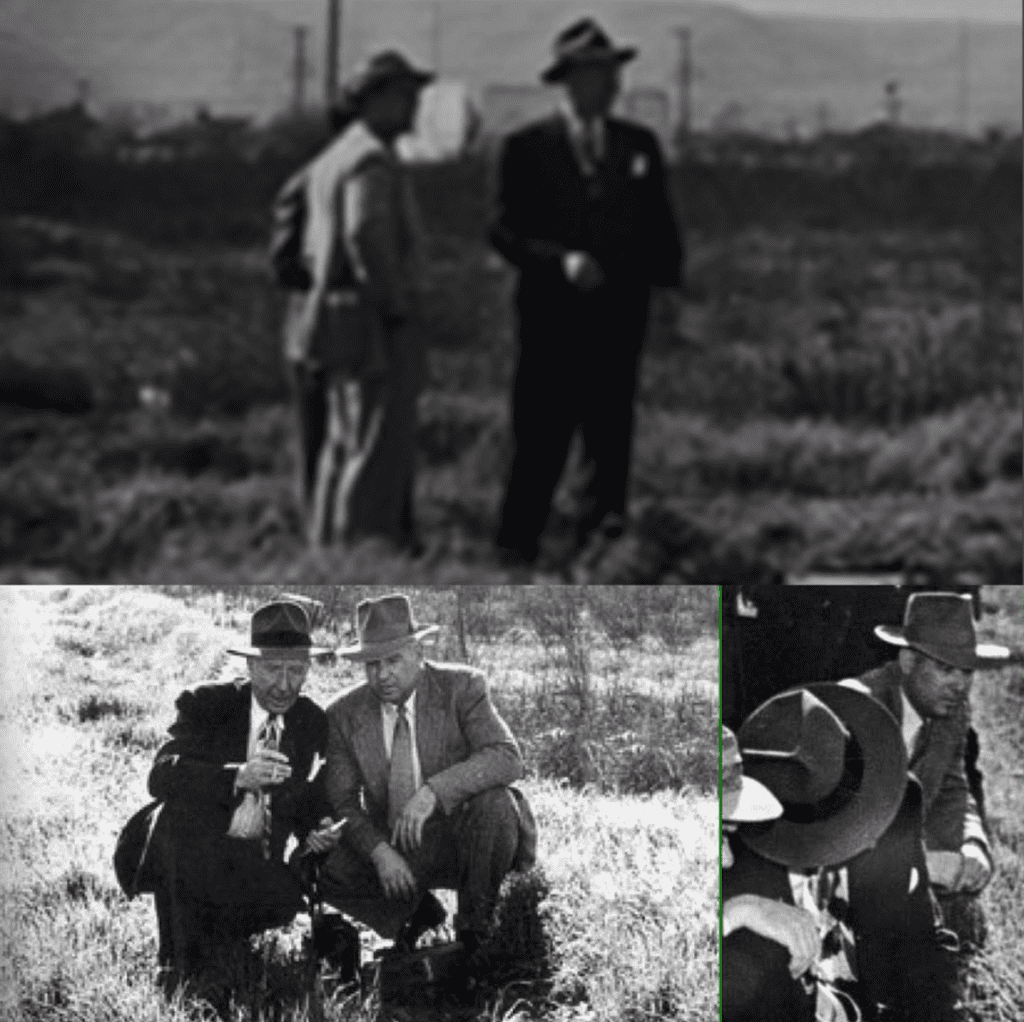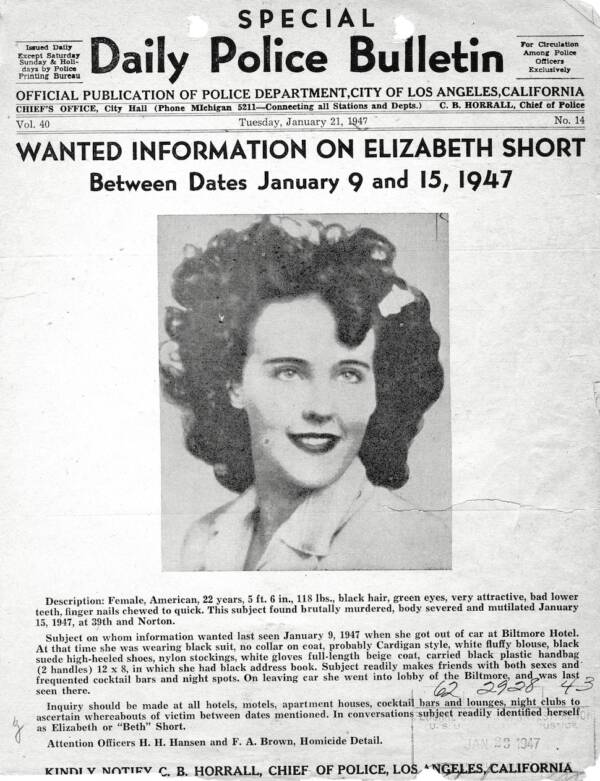Unveiling The Black Dahlia: Photos & Untold Truths
Can a single photograph truly capture the essence of a tragedy, or does it merely offer a voyeuristic glimpse into a moment of unimaginable horror? The case of the Black Dahlia, and the graphic crime scene photographs that followed, continues to ignite both fascination and debate, proving that images can be both evidence and a source of ethical contention.
The Black Dahlia case, the brutal murder of Elizabeth Short in 1947, remains etched in the annals of true crime as one of the most infamous unsolved mysteries. The crime scene photos, documenting the macabre details of Short's death, have become iconic, sparking endless speculation and debate among true crime enthusiasts and investigators alike. These images, frozen in time, offer a chilling glimpse into the darkness of a bygone era, a period when Los Angeles, a city of dreams, was also grappling with its underbelly of violence and corruption.
On January 15, 1947, a woman stumbled upon a gruesome scene in the 3800 block of Norton Street, in the Liemert Park neighborhood of Los Angeles. What initially appeared to be a discarded department store mannequin turned out to be the mutilated body of a young woman. The victim was Elizabeth Short, a 22-year-old aspiring actress, who would posthumously become known as the Black Dahlia, a moniker derived from her dark hair and the popular film noir aesthetic of the time. Her murder, characterized by its extreme brutality, quickly captured the public's attention, sparking a media frenzy that would continue for decades.
- Hdhub4u Movie Downloads Your Guide To Bollywood Hollywood Films
- David Rebecca Muir Wedding A Look At Their Love Story
The crime scene photos, depicting the horrific state in which Short was found, became a crucial element in the investigation. These images, often graphic and disturbing, were studied meticulously by law enforcement, forensic experts, and, later, by a legion of true crime aficionados. They provided invaluable clues about the nature of the crime, the methods employed by the perpetrator, and the potential motives behind the murder. However, these same photographs also ignited ethical debates, raising questions about the appropriateness of publicly disseminating such gruesome material.
The photographs are more than just documentation of a crime; they are a window into the social climate of 1940s Los Angeles. The city, then experiencing a post-war boom, was a melting pot of ambition, glamour, and hidden dangers. Short's story, a tale of a young woman chasing Hollywood dreams only to meet a tragic end, reflected the anxieties and contradictions of the era. The brutal nature of the crime and the mystery surrounding the killer amplified public fear and fascination, making the Black Dahlia case a cultural touchstone.
The enduring interest in the Black Dahlia case can be attributed to several factors. The lack of a definitive solution has fueled endless speculation, leading to books, documentaries, and countless online discussions. The crime's inherent mystery, combined with the evocative imagery of the crime scene photos, has captivated true crime enthusiasts who are eager to unravel the puzzle. The case also resonates with audiences due to its reflection of timeless themes: the allure and dangers of fame, the darker aspects of human nature, and the quest for justice.
- Discover News Biography Sasha Prasad Insights Today
- Yololary Leaks Unveiling The Controversy Its Impact
Over the years, numerous photographs claiming to be the original Black Dahlia morgue photos have surfaced, adding to the confusion and misinformation surrounding the case. Separating fact from fiction has become an increasingly challenging task, as the authenticity of some images remains in question. This proliferation of unverified material underscores the need for critical analysis and a healthy skepticism when engaging with true crime narratives.
The Black Dahlia case is not merely a story of a heinous crime; it is a complex narrative that explores human tragedy, societal intrigue, and the relentless pursuit of justice. The crime scene photographs, though disturbing, serve as a stark reminder of the brutality that can exist, and also of the enduring impact of unsolved mysteries.
| Attribute | Details |
|---|---|
| Full Name | Elizabeth Short |
| Nickname | The Black Dahlia |
| Date of Birth | July 29, 1924 |
| Place of Birth | Hyde Park, Boston, Massachusetts |
| Date of Death | January 15, 1947 |
| Cause of Death | Homicide (Mutilation) |
| Crime Scene Location | 3800 block of Norton Avenue, Los Angeles, California |
| Occupation | Aspiring actress, waitress |
| Physical Description | Dark hair, often described as glamorous |
| Known For | Being the victim in the unsolved Black Dahlia murder case |
| Link to Reference | Britannica |
The enduring popularity of true crime content has brought these ethical dilemmas to the forefront. While there's a growing awareness of the sensitivity surrounding graphic content, the balance between factual reporting and sensationalism remains a delicate one. The debate over the ethics of showing disturbing photos, especially in cases involving vulnerable victims, continues to evolve.
Photographs, unlike live video, capture a single, unmoving instant. The Black Dahlia crime scene photos freeze a moment of unimaginable violence, leaving the viewer to confront the horrific details frozen before them. This characteristic has the effect of intensifying the emotional response and forcing the viewer to linger on the details of the crime. It is one of the defining factors in the case's lasting impact.
The release and widespread circulation of these photographs have, undeniably, contributed to the public fascination with the Black Dahlia case. They are an important element in this notorious murder. They also serve as a stark reminder of the potential for violence and the human cost of unsolved crimes.
The investigation into the Black Dahlia case was extensive, involving numerous leads and suspects. Despite the efforts of the Los Angeles Police Department, the case remains unsolved. This unsolved nature is an additional driver of public interest, as the mystery compels true crime enthusiasts to analyze the evidence and offer theories, as well as create a continuing dialogue about the case and its many complexities.
The crime scene photos from this case have become symbols of both horror and fascination. They offer a glimpse into the brutality of the era. The graphic nature of the images has, over the years, sparked a great deal of debate. Some believe they are essential evidence. Others feel the photos are exploitative.
The Black Dahlia's murder case has captured the public's attention for decades. The release of the crime scene photos only adds to the mystery and intrigue surrounding this infamous, unsolved crime. These photos offer a haunting glimpse into the gruesome murder of Elizabeth Short, a young woman whose life was cut short in the most horrific way. These images are not just evidence; they are also a reflection of the era's social values and the evolution of crime reporting.
These photographs became a significant element of the investigation and subsequent public fascination. They documented the victim's state, providing crucial evidence for investigators. The photos also served to shock the public and fuel their interest in the case. The images continue to be studied by investigators, forensic experts, and true crime enthusiasts. They provide clues about the nature of the crime and the killer's methods.
The gruesome details of the crime scene and the graphic photos have left an indelible mark on our memories. It is impossible not to feel sympathy for Elizabeth Short. She was a young woman seeking fame and fortune, who met an unfortunate, tragic end. The photographs tell a story of violence, mystery, and a relentless quest for justice. It is a tale that continues to haunt and captivate audiences.
The Black Dahlia case erupted into public consciousness on January 15, 1947, forever changing the landscape of true crime reporting and Los Angeles history. The images, a stark representation of brutality, have become symbols of the dark underbelly of the city. The case, and the photos, became cultural icons, sparking the imagination of writers, filmmakers, and artists.
The story of Elizabeth Short's murder is a testament to the enduring power of the image, its ability to simultaneously inform, shock, and compel. It is a reminder of the importance of ethical considerations in true crime and the need for responsible media consumption. The Black Dahlia's story, and the haunting images that accompany it, continue to challenge us to confront the darker aspects of human nature and to seek justice for those whose voices were silenced.
The Black Dahlia murder case is a complex mix of human tragedy, societal intrigue, and the enduring quest for justice. The crime scene photographs depict the brutal nature of the crime and became a significant element of the investigation. The images offer a glimpse into the brutality of the era. The case is a cautionary tale. It reminds us of the importance of seeking justice and the lasting impact of unsolved mysteries.



Detail Author:
- Name : Grayson Greenholt
- Username : wstiedemann
- Email : reichel.jacynthe@gmail.com
- Birthdate : 1996-07-17
- Address : 116 Alessandro Station New Gregoriatown, GA 53996
- Phone : (469) 397-8460
- Company : Murray Inc
- Job : Dentist
- Bio : Illum culpa id autem alias est aut a. Perspiciatis quis aspernatur non consequuntur nisi. Sint non id eveniet ut. Quibusdam quia est praesentium animi maiores consequatur.
Socials
tiktok:
- url : https://tiktok.com/@dianna.vandervort
- username : dianna.vandervort
- bio : Ipsam voluptas qui enim vel.
- followers : 2367
- following : 273
facebook:
- url : https://facebook.com/vandervort2007
- username : vandervort2007
- bio : Eligendi velit molestiae repellat quia libero error quos sapiente.
- followers : 910
- following : 159
linkedin:
- url : https://linkedin.com/in/dianna_id
- username : dianna_id
- bio : Odio veniam quis libero vero.
- followers : 504
- following : 2669